The Pen is Mightier: Interview with Cartoon Satirist Gerald Scarfe
Gerald Scarfe's legendary satirical cartoons have graced the pages of Private Eye and the Sunday Times, as well as the walls of the Rosewood Hotel bar...
This post may contain affiliate links. Learn more
The current political turmoil proves fertile ground even for cartoon satirist Gerald Scarfe, who has seen it all, says Teresa Levonian Cole. He catches up with C&TH to talk Thatcher, Trump and what lies behind his brand of savagely funny ‘ultra-truth’…
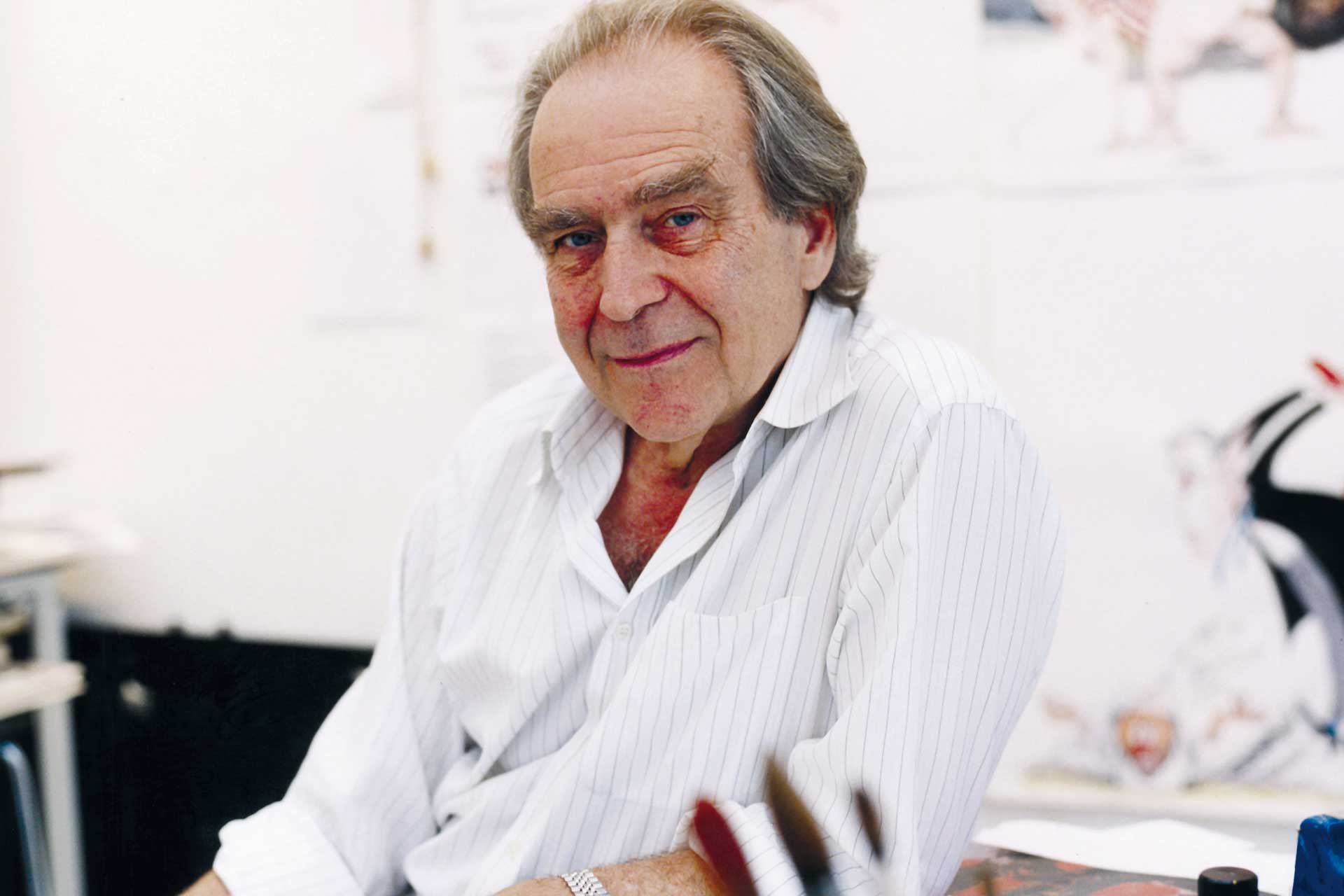
Gerald Scarfe, now 80, still produces his satirical cartoons for the Sunday Times
Not many people have granted the honour of having a dinosaur fossil named after them. ‘Well,’ says Gerald Scarfe, ‘a paleontologist rang me up one day, and said he had discovered this new kind of pterodactyl in Dorset, and could he name it after me.
I was a bit surprised, and asked him why, and he said it reminded him of my drawings of Margaret Thatcher. I often drew her as a pterodactyl, you see.’ I saw: it was sitting right there, a model of Cuspicephalus Scarfi, with its long, rapacious beak – the spitting image of Baroness Thatcher in full flight.
Scarfe’s Chelsea studio
I too was sitting there, in Gerald Scarfe’s studio, a large airy loft built atop his home – an elegant, five-storey, red-brick building overlooking the river in Chelsea. Scarfe sat opposite me, in a battered leather armchair, next to his bird. Behind him, a large statue of a horse’s head from the Parthenon, purchased from the British Museum shop. ‘It cost a fortune,’ he says, ‘but I wanted a noble model for Pegasus, a horse fit for the gods.’
This was for Hercules, the 1997 Disney feature on which Scarfe worked as production designer – ‘the last film they made with drawings. Now it is all CGI…’ He had a flirtation with film-making, too, winning a BAFTA for a programme he made for BBC’s Arena. The golden mask perches, casually, on a pile of books.
It is not a tidy studio. Books, newspaper cuttings, sketches, reams of paper measuring 24×33 inches are scattered over every surface, and on the paint-splattered floor. And buried beneath all the flotsam, an exercise bicycle, and a pair of dumbbells.
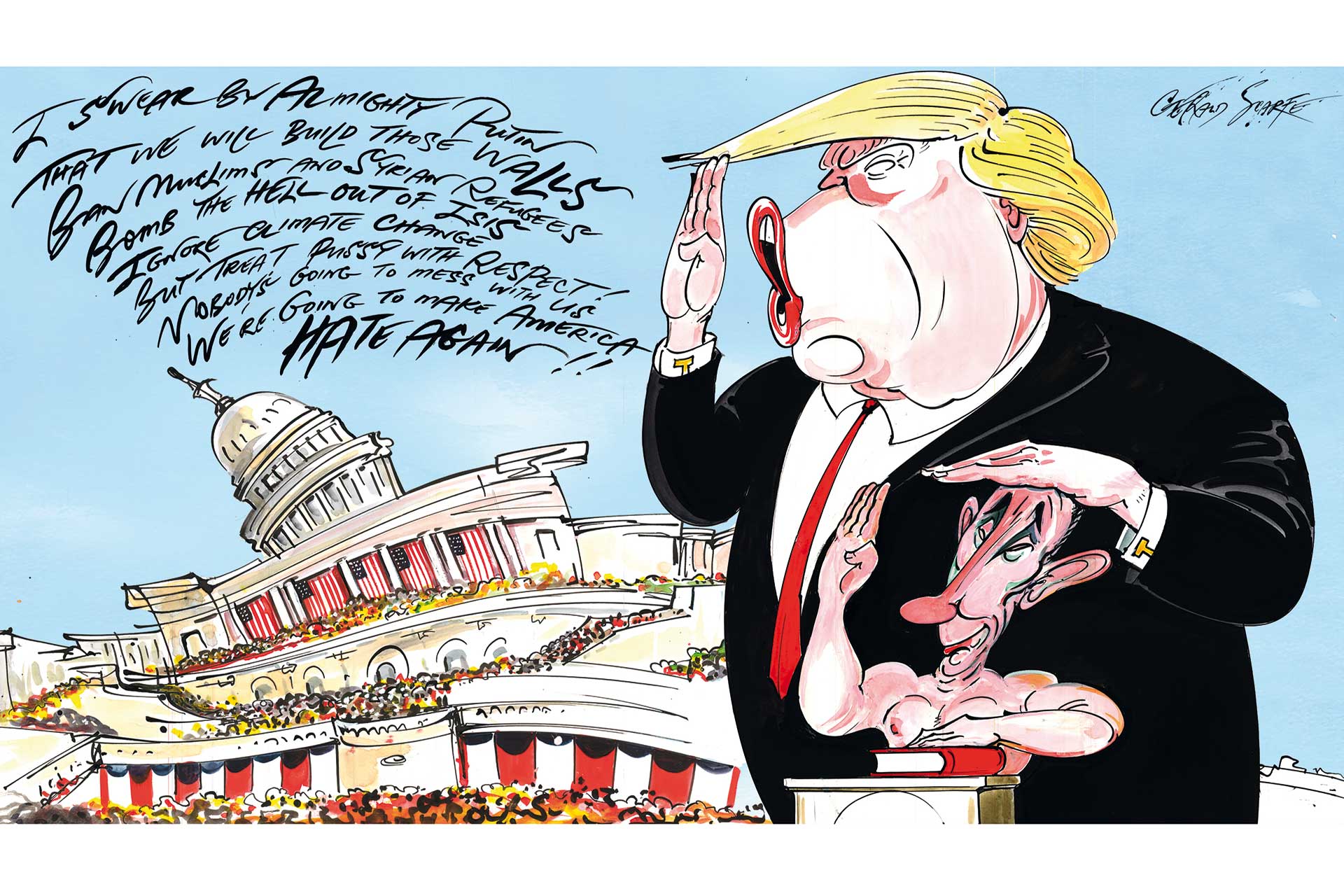
‘Donald Trump – I Swear’
The Pros of Trump
My gaze, however, is drawn to a long wall, on which a number of works-in-progress are pinned. It is for these – his savagely funny satirical drawings of political figures – that Gerald Scarfe is best known. There’s Donald Trump, like an overgrown Neanderthal Bamm-Bamm, wielding a club. There’s Trump, transmogrified into a bull, rampaging through a china shop. Trump again – this time, leaning over the hospital bed of a derelict, with the caption ‘Giving the kiss of life to ugly America’.
If nothing else, the President of the United States of America is a fertile source of artistic inspiration. ‘I’m very lucky,’ says Scarfe, ‘to have this space in the Sunday Times where I can cry out against the misuse of power. Not that it does much good.’
‘With a few quick lines, he can destroy or make a reputation,’ Harold Evans, the legendary editor of the Sunday Times, once said of Scarfe, whom he employed in 1967
Harold Evans, the legendary editor of the Sunday Times, would disagree. ‘With a few quick lines, he can destroy or make a reputation,’ he once said of Scarfe, whom he employed in 1967, with the words: ‘I’m a radical, you’re a radical, we should work together’. And Scarfe, now 80, his beetling brows just slightly greyer, has been producing cartoons for the newspaper, ‘once a week, like a vicar’ ever since.
Other Projects
The rest of the time he spends on ‘other projects’, which have included designs for everything from opera to Pink Floyd, ballet to the Royal Mail. And, of course, his books, where you can see drawings not easily found elsewhere. His caricature of Stravinsky – to whom he was introduced by Stephen Spender – one of six intellectuals in America he was asked to draw by Encounter magazine, is case in point.
‘Most of the other subjects, who included Aaron Copland and Arthur Miller, were happy to sign the drawings,’ says Scarfe. ‘But Stravinsky said “why should I sign it? I didn’t draw it!” So I asked him to sign it for Stephen. Stravinsky agreed. “To Stephen Spender,” he wrote. “A good drawing by Gerald Scarfe.” The only problem was that I then realised I’d have to give it to Stephen! His family has it now.’
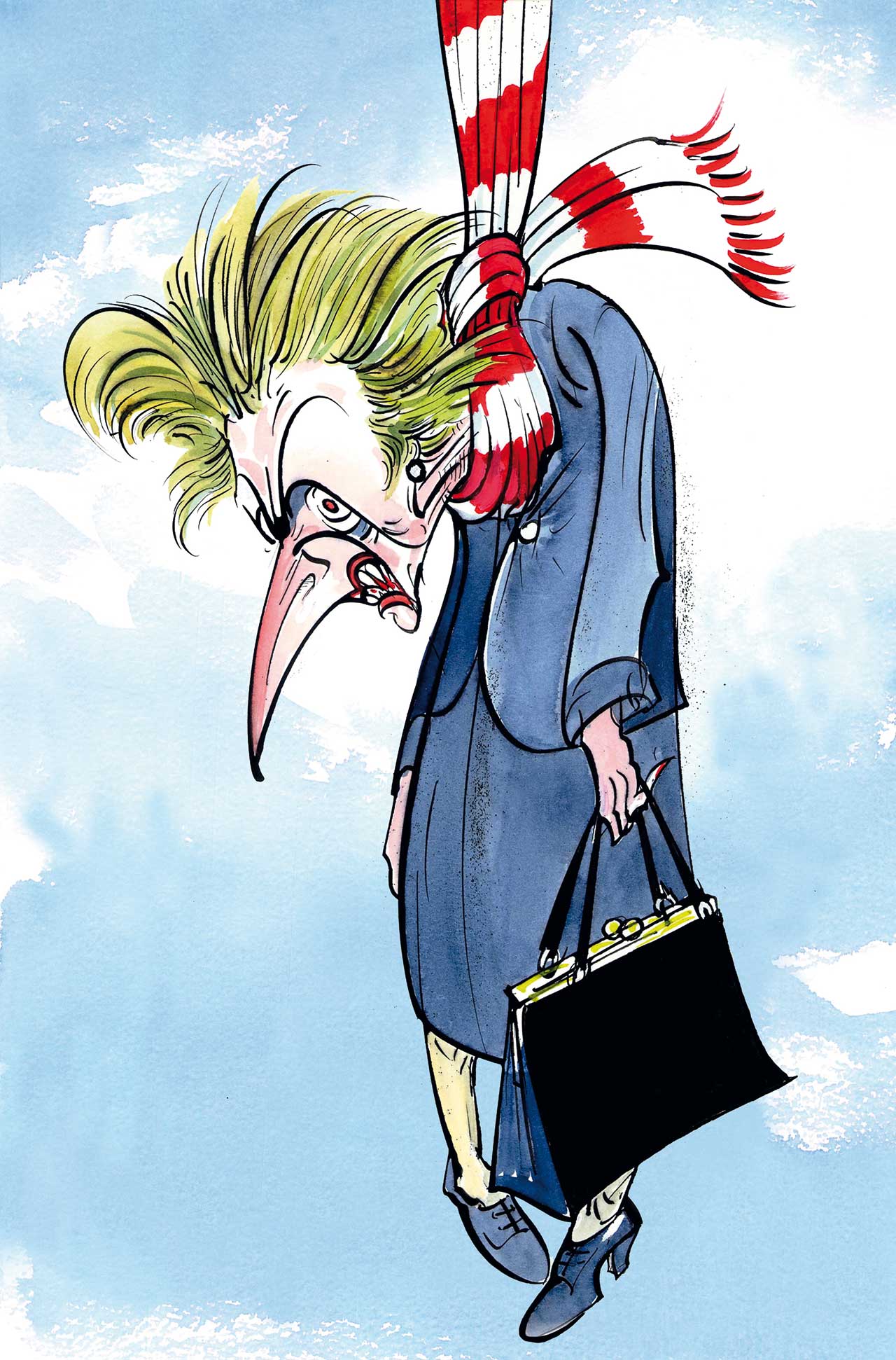
Margaret Thatcher: Hung By Scarfe
‘Delusions of Grandeur’
The caricatures themselves derive from the subject’s character. ‘Thatcher, for example, lent herself to sharp objects – you couldn’t draw her like a dove!’ Inspiration often arrives like a dream image, which has to be captured on paper it before it evaporates.
Standing at his desk, Scarfe works on a large scale, applying ink directly onto that daunting blank sheet. ‘Most cartoonists work from the wrist. I have delusions of grandeur,’ he jokes, ‘and sweep with my arm. I don’t use pencil first – it dissipates the energy. It is all about the line. If I don’t get that right, I can tell it won’t work. Getting what’s in one’s mind onto paper can be exhausting.’
But the path to the Sunday Times and acclaim – awards, international exhibitions, and a CBE, inter alia – was not altogether smooth. ‘I had a black childhood,’ says Scarfe, referring to the severe asthma that kept him hospitalised during much of his younger years, depriving him of schooling: ‘some people think it led to my black view of life.’
His outlet was drawing (precociously dark images survive from this period) and, aged 16, Scarfe beat David Hockney into second place in a drawing competition in the Eagle comic. Not knowing what to do, he joined his uncle’s advertising company. ‘I hated it!’ he says. ‘I had to draw flat, boring things and make them look luxurious and enticing. I was telling lies.’
‘The caricaturist is the opposite of the portrait painter, whose job is to flatter. Who knows how different history might have been if Holbein had presented Henry VIII with an honest portrait of Anne of Cleves!’
Private Eye
Abandoning commercial art, he found himself at Private Eye, with free rein to indulge his talent. ‘From lies to ultra-truth,’ says Scarfe. ‘It was a breath of fresh air.’ Air animated that notorious drawing of Harold MacMillan as a naked Christine Keeler [during the Profumo scandal], which first propelled Scarfe into the limelight.
‘Hogarth, Gillray, Rowlandson… there is a British tradition of questioning one’s “betters”, expressed with a rather lavatorial sense of humour,’ says Scarfe, who believes his role as ‘a kind of court jester’ gives him licence to go where angels fear to tread. ‘The caricaturist is the opposite of the portrait painter, whose job is to flatter. Who knows how different history might have been if Holbein had presented Henry VIII with an honest portrait of Anne of Cleves!’
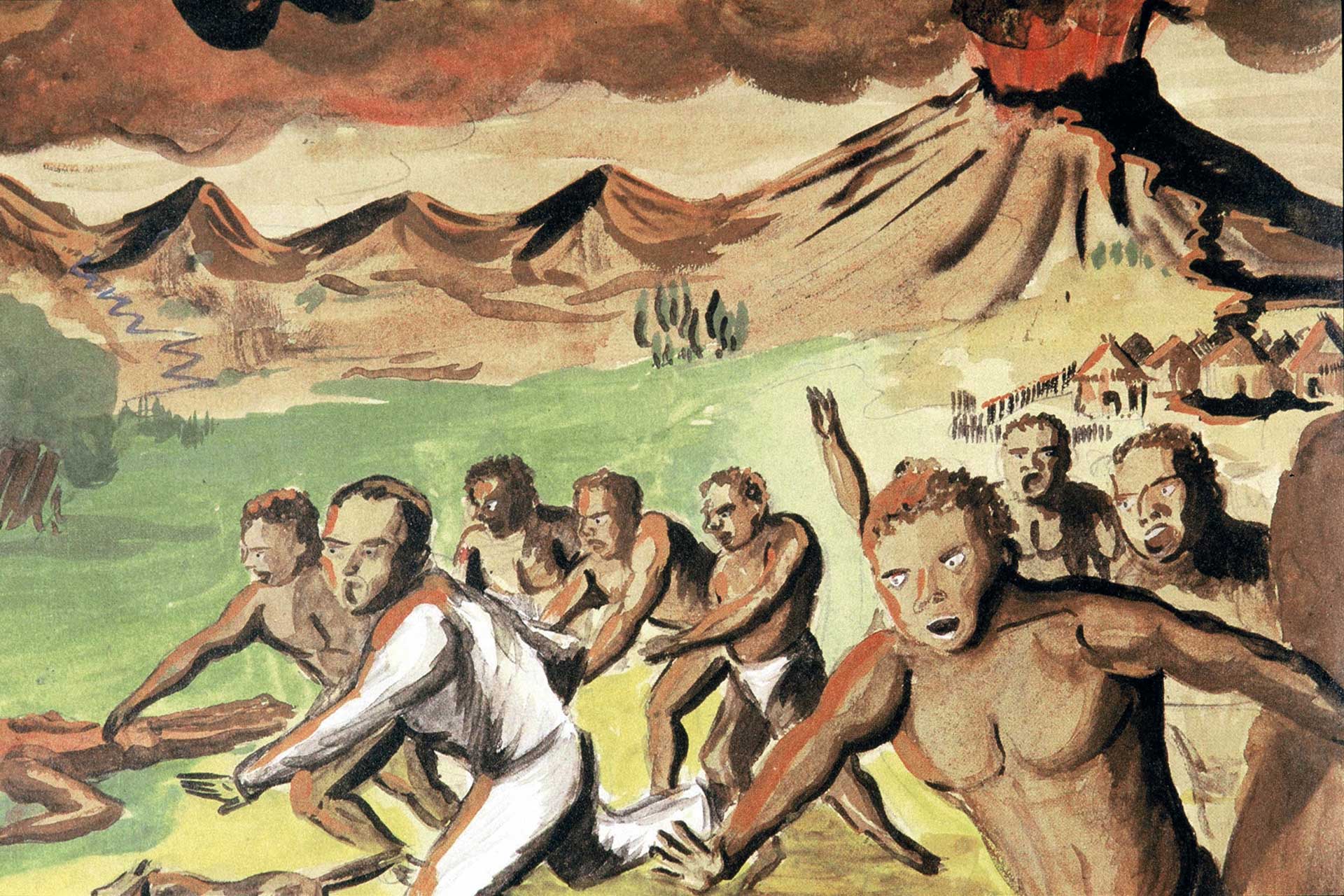
Nightmare- Volcano is one of Scarfe’s childhood pictures that exhibits his prepensity for the dark side of life
Images of War
He was less fortunate at the Daily Mail, who, finding they had bitten off more than they could chew, sent Scarfe off to Vietnam – an experience that quickly disabused him of any ‘John Wayne- type heroic images’ of war. The Six-Day War and The Troubles in Northern Ireland followed, courtesy of the Sunday Times.
He was hijacked by the IRA. ‘l was sitting in the passenger seat of my rented Cortina, in a no-go zone, with burnt out cars and concrete blocks, drawing up against the dashboard,’ he explains. ‘And these dangerous-looking men got into the car and stuck a gun in my ribs. “This is official,” said one, and drove off.’
They let him out after five minutes, not without first complimenting him on his work. “You’re a brave drawer,” one of them told me. I later learnt they blew up the post office the next day. Apparently the IRA liked Cortinas, because they had big boots, which could hold lots of gelignite.’
The Sunday Times brought him back in from the cold. Here, Scarfe learnt the art of self-censorship. ‘Some drawings – like the one of Trump speaking out of his backside – my editor wouldn’t publish. But it’s therapeutic – I exorcise my anger in my work. And such drawings can go into my books, or on the walls of the bar [Scarfes Bar, named after him, in London’s Rosewood Hotel]. I change the drawings periodically, so that they remain topical.’
Legal Adventures
Has he ever been sued? Once, he says. In 1971. ‘Mary Whitehouse went to see the Pope, to complain about British morals [following a “Schoolkids’” issue of Oz]. So I did a drawing of her in a, er… compromising position, with Rupert Bear – the magazine’s symbol – in front of the Pope. It was called ‘Mrs Mary Righteous explains her position’. The funniest part was the lawyer’s letters, describing the picture…’
‘Are you writing a book?’ he asks suddenly, only half-joking, I suspect. I glance at my watch and see several hours have elapsed. Just one last thing: the name, Scarfe..? ‘It’s from Lancashire. A Viking name, apparently. It means a kind of cutting blade’.
The very definition of his pen. And the cue to take my leave.
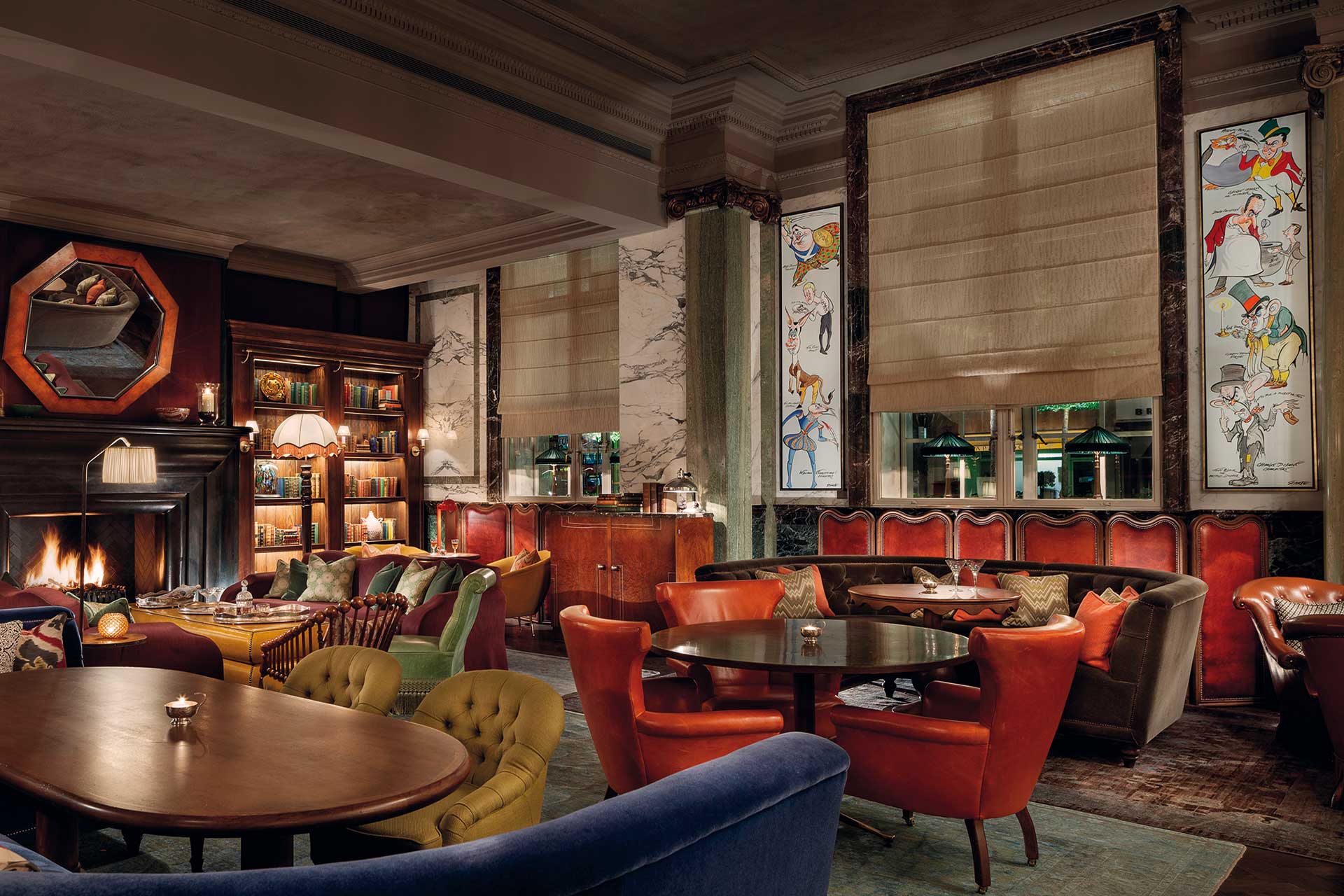
Surround yourself with Scarfe at Scarfes Bar at the Rosewood Hotel in London
Gerald Scarfe undertakes commissions.
MORE CULTURE: The Art Scene: Q&A with Tim Braden | The Art Scene: Q&A with Art Advisor Wenty Beaumont | Artist Chris Levine on Art, Light & His Most Famous Sitters
